1957 French Grand Prix race report: "Old Man" Fangio takes third win of season
Experience counts for Juan Manuel Fangio as he sees off Ferrari challenge to becomes the first master of Rouen
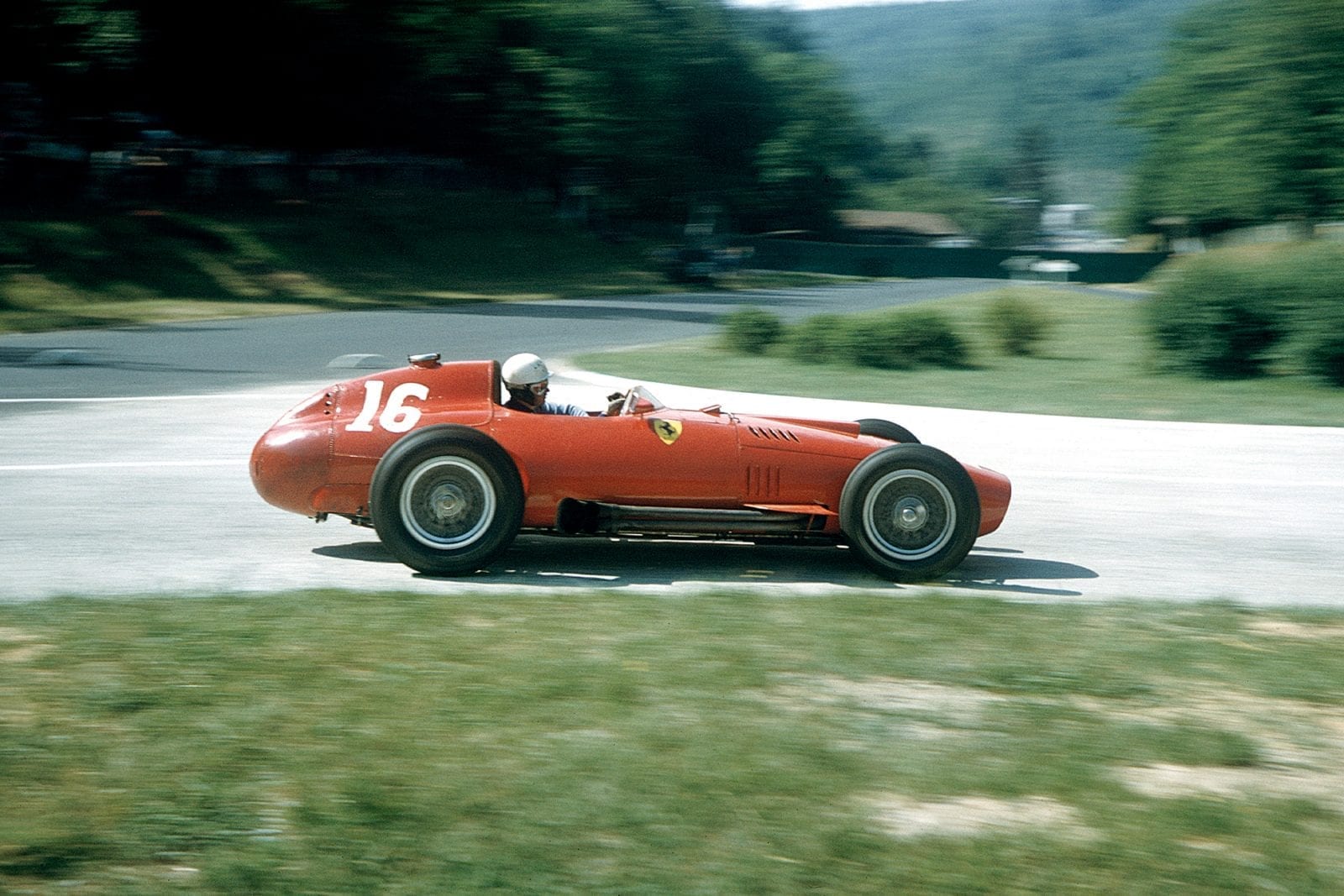
Maurice Trintignant started eighth in the handsome Ferrari 801
Motorsport Images
After trying for many years, the Automobile Club Normand at last succeeded in wresting the French Grand Prix away from the Automobile Club du Champagne, and this year’s race was held on the wonderful natural road circuit of Rouen-Les Essarts. This circuit is without question the finest in France and approaches the Spa circuit for the ultimate in Grand Prix courses.
In the past it has only been lack of organising finance that has prevented the French Federation letting the Grand Prix of their country be run at Rouen, but this year the problem was solved and the French Grand Prix became a Grand Prix in the true sense of the words, rather than a flat-out blind as happens at Reims.
Situated a few miles south of Rouen, in the forest of Les Essarts, the 6.542-kilometre circuit contains everything from tight hairpins to 150mph corners, steep uphill sections, and a wonderful 100-120mph series of downhill swerves of the type that really sorts out the men from the boys in Grand Prix cars.
Spectator value is at its best at Rouen for the whole of this downhill dice is visible from a very high embankment that runs along the left-hand side of the road, and to see “the master” in a 30deg slide at 100mph from a vantage point almost directly above is to see the art of Grand Prix driving at its best. This was the first occasion on which Formula 1 cars have competed on the revised Rouen circuit and, with an entry of 15 cars, only one of which was privately owned, the other 14 being factory cars, it meant that practice just had to be seen, in spite of being early on Friday morning.
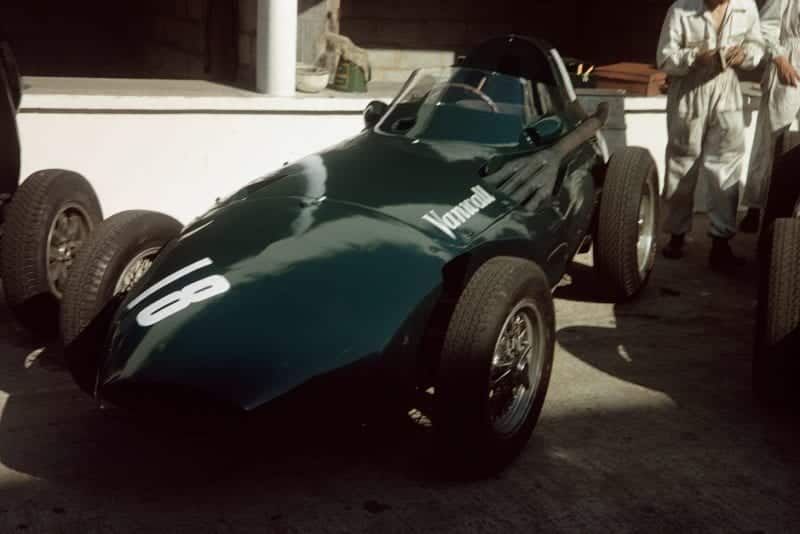
Finding themselves without usual drivers Moss and Brooks, Vanwall drafted in Stuart Lewis-Evans
Motorsport Images
Qualifying
Fangio was making his first visit to Rouen and he took one look at the circuit, rubbed his hands, and said, “This is for me,” whereupon he proceeded to throw the six-cylinder and 12-cylinder Maseratis round the circuit in a manner that demonstrated his driving style and ability more continuously than one has seen for a long time. On most circuits there is perhaps one corner on which he demonstrates his ability over all others, but from all round the Rouen circuit came reports of the fantastic way the “old man” was sliding the Maserati through the fast bends.
Certainly, on the downhill swerves he was the only one who was motor-racing, with the possible exception of Musso, who seemed to be at the top of his form, while Behra was motoring very fast, aided by an intimate knowledge of the circuit from past races with sports cars. It was Behra who set the pace on the first morning, but only until his team leader had found the way round, and the Scuderia Maserati were in fine condition, having four six-cylinder cars and one 12-cylinder car for their drivers to play with, the team men being Fangio, Behra, Menditeguy, Schell and Scarlatti, the last-named being reserve.
“For the British it was a sad day, for Vanwall was robbed of the services of Moss and Brooks”
The Scuderia Ferrari were out in full force with their V8 Lancia-Ferraris, driven by Musso, Collins, Hawthorn and Trintignant, and though they were going fast the cars did not seem so suited to the contours of the Rouen circuit as did the Maseratis.
For the British it was a sad day, for Vanwall was robbed of the services of Moss and Brooks, the former suffering from a nasal disease caught while holidaying on the Mediterranean, and the latter not yet fully mended after his Le Mans crash. For the first day of practice Salvadori was the only Vanwall driver, he having changed his cars in mid-season, abandoning the BRM contract in favour of a Vanwall one, and he spent the morning trying the Vanwall cars and feeling his way into their characteristics. The second car of this team remained empty, though various drivers kept sniffing round it in the hope that they would be invited to drive.
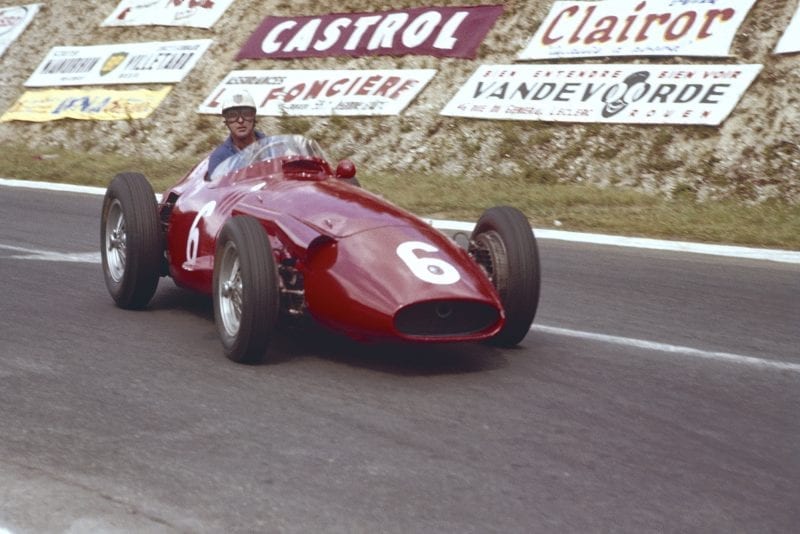
Schell was one of five pilots Maserati brought to the meeting
Motorsport Images
With Salvadori out of the BRM team Bourne was relying on the faithful Flockhart, while “new boy” Mackay-Fraser was being given a try-out in the second car, taking things quietly and steadily and not doing anything heroic that might end in disaster. To complete the works teams there were a pair of Coopers with rear-mounted Coventry-Climax twin-cam engines, these cheeky little cars being driven by Brabham and McDowell, and the Surbiton lads even brought along a third car as a practice machine, just like Mr Maserati and Mr Vandervell. Looking rather lonely and being the only private owner accepted for the race was Horace Gould with his Maserati, making the field up to 15, there being no Gordini, no Bugatti and no Connaught, these three teams having fallen by the wayside in the “race for survival that is Grand Prix racing.”
As the morning grew warmer and warmer, Rouen being in a heat wave, Fangio’s pace got hotter and hotter, and he finished the practice with fastest time on the six-cylinder car and second fastest time using the 12-cylinder car, while Behra was third fastest; so that Maserati were jubilant. Ferrari were not so happy, Collins only just beating Musso for fourth best time and the other two being way down in midfield, being beaten by Flockhart with the BRM. Had Brooks and Moss both been fit enough to drive, there is little doubt that the Vanwalls would have been well up amongst the Maseratis, but as it was, Salvadori was not as fast as Flockhart, having tried the car allocated to him and the practice car, and deciding to use the practice car for the race, preferring its characteristics.
Next morning saw another early practice session and once again Fangio outshone everyone, his cornering under full power in long controlled slides being a poem of mechanical artistry. He continually threw the car into deliberate slides on his approach to the fast open bends and drove round on full power, judging the slide to a nicety so that it finished a few inches from the kerb. The result was an even faster lap than the day before, and though Behra was really trying he could not approach Fangio’s time for the first day of practice, while Musso was the only other driver to look like staying with Behra.
The Vanwall team were a little happier this morning for they borrowed Lewis-Evans from Ferrari to drive the second car, as Moss was still in hospital and quite unfit for any racing. Like Mackay-Fraser with the BRM, Lewis-Evans was feeling his way in the Vanwall with caution, while Salvadori was getting quicker, but this loss of star drivers was putting the green cars back to the position they used to be in a few years ago, that of filling in the rear ranks of a Grand Prix, which was heartbreaking after the progress we have seen these past two years.

Ferrari 801s line-up in the pits waiting to be serviced
Motorsport Images
Everybody in the Maserati team tried all the cars, and Fangio even did a few laps in the old works-hack, and all the time it became more and more obvious that the Maserati was really suited to the Rouen circuit. Before the morning finished there occurred one of those incidents that a good team manager “has kittens” over, for, quite by chance, four cars came by in close formation, in the order Behra, Fangio, Collins and Musso.
An unholy dice commenced in which Behra was not going to be passed by Fangio, although the “old man” was going at a speed that was faster than Behra anyway; Collins, seeing Fangio in front, tried to hang on to his tail, and Musso was out to get Collins. For lap after lap this quartet seared round the circuit, until Fangio went round the outside of Behra on the downhill swerve after the pits, and then it was all over, but Musso had worn Collins down and Behra had made second fastest lap of the day. This little incident turned out to be the best bit of Grand Prix racing throughout the whole meeting.
“Only those who saw Fangio in action can appreciate how he managed a time differential of 1.1sec over the next man”
It has become normal in a major Grand Prix for the leading six or seven cars to be separated by fractions of a second, a time of one-tenth of a second being sufficient to space drivers on the front row, but this time, due to the exacting nature of the circuit, Fangio was 1.1sec faster than Behra, with a time of 2min 21.5sec; Musso was only 0.1 sec slower than Behra, followed by Schell 0.5sec behind and 0.1sec, quicker than Collins. The times and grid order was as follows: Fangio 2min 21.5sec; Behra 2min 22.6sec; Musso 2min 22.7sec; Schell 2min 23.2sec; Collins 2min 23.3sec; Salvadori 2min 25.1sec; Hawthorn 2min 25.6sec; Trintignant 2min 25.9sec; Menditeguy 2min 26.1sec; Lewis-Evans 2min 27.6sec; Flockhart 2min 27.8sec; Mackay-Fraser 2min 29.9sec; Brabham 2min 30.9sec; Gould 2min 35.0sec; and McDowell 2min 38.9sec.
It will be seen that the general run of drivers was keeping well to form, beating each other by the odd tenth of a second, but only those who saw Fangio in action can appreciate how he managed a time differential of 1.1sec over the next man. After this wonderful demonstration during the practice periods it almost seemed a waste of time to run the race itself, but as that was the whole point of the meeting the cars lined up on the grid in the heat of the afternoon sun on Sunday, July 7th.
Race
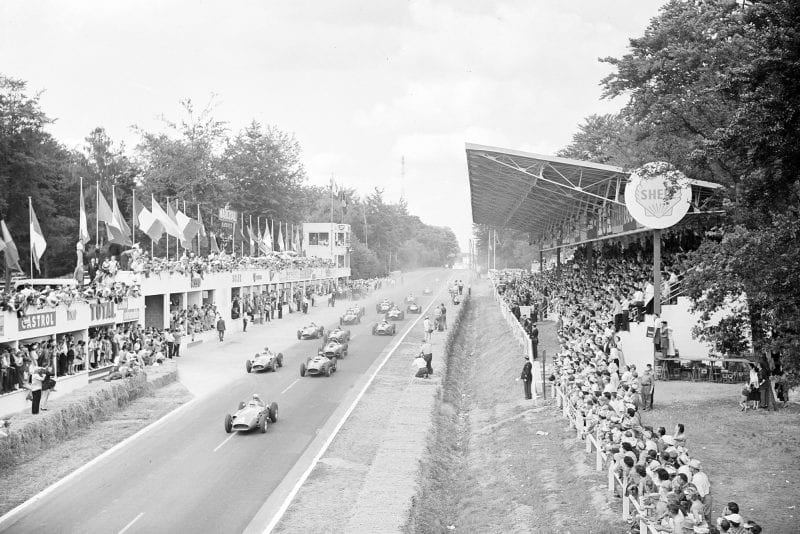
Tyres smoke as the cars make their getaway at the start, Behra taking the initial lead
Motorsport Images
The start was unforgettable, for there was a rule that all cars had to be started by mechanical starters, no pushing was allowed, and with the cars in three-two-three order, with Maserati, Maserati and Ferrari on row one, Maserati and Ferrari row two, Vanwall, Ferrari and Ferrari row three, Maserati and Vanwall row four, BRM, BRM and Cooper row five, and Maserati and Cooper row six, it could be seen that there would be some rushing about by the mechanics with the portable starters.
Due to a crowd of spectators falling off a footbridge the start was delayed quite a time and nerves were on edge over this engine-starting business, until suddenly the organisers said “one minute to go,” whereupon all hell broke loose. Mechanics pushed starters up the tails of the Ferraris and got in the way of Vanwall mechanics inserting starters in noses of the green cars; Trintignant’s car would not start, neither would Menditeguy’s; people tripped over starter-cables; batteries were being ground flat; and at the back of the field Gould was in a sweat waiting for the works mechanics to come to his aid.
While all this was going on the 30sec signal was given and the front row snicked into gear and began to creep. Then the man with the flag realised that some of the cars had not started and that the track was covered with starter trolleys, cables and mechanics, so the final 30sec was prolonged for well over a minute, those drivers who were ready, trembling on the clutch pedal, not realising why there was a hold-up. As the last mechanic left the grid everything happened at once and in the middle of it all the flag fell, but Behra was already well on his way, Musso was stationary with his rear tyres nearly on fire with wheelspin, everyone dodged everyone else, and the snarling pack rushed away down the hill towards the hairpin at Nouvelle Monde.
The relief when all this excitement disappeared was almost painful to experience, but very soon the 15 cars could be heard roaring their way up the hill on the far side of the circuit and it was Musso who was leading the opening lap, followed by Behra, Fangio, Collins, Schell and, of all things, a BRM, driven by Mackay-Fraser. On the next lap Fangio took second place and on lap three he was close behind Musso and ready to go into the lead.
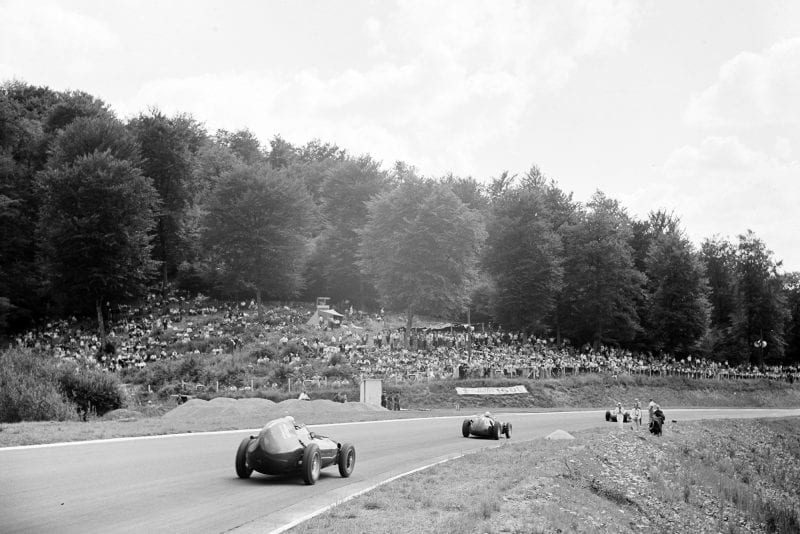
Fraser-Mackay leads Lewis-Evans as the track winds through the forest
Motorsport Images
On this lap Salvadori slid on the bend before the pits and spilt some oil and Flockhart, who was following, lost his BRM, went off the road, wrote the car off and sustained leg injuries. The Vanwall driver stopped at his pit for the oil-tank cap was undone, and when he set off again he was almost at the end of the field. Lap four saw Fangio well in the lead and from then on he settled down to increasing his lead every lap, setting up fastest lap after fastest lap. Musso was really going well, and though he could not challenge the leading Maserati he was holding on to second place ahead of Collins, Behra, Schell and Mackay-Fraser, the last-named making the BRM really show its paces.
The little Coopers, being underpowered, were running at the back of the field and Brabham had an unfortunate mix-up with Gould when the latter’s axle seized, and the result was that both retired on lap five, the Cooper having bent its rear suspension on some straw bales. Then Trintignant came into the pits with his Lancia V8 engine misfiring, and started a series of stops to try and make it run on eight cylinders.
“On this lap Salvadori slid on the bend before the pits and spilt some oil and Flockhart, who was following, lost his BRM, went off the road and the wrote the car off”
Menditeguy got into his stride and passed Lewis-Evans in the Vanwall and Mackay-Fraser in the BRM, and began to chase after Schell, while Hawthorn was having difficulty in getting rid of Mackay-Fraser. For a number of laps these two passed and re-passed, and eventually Lewis-Evans caught them up and joined in the dice. Menditeguy was battling with Schell, passing and re-passing; meanwhile, way out ahead of everyone else, Fangio was continuing to set up new lap records and was now 11sec ahead of Collins, who had got himself ahead of Musso. By 25 laps Collins was in the swing of things and set up a new lap record on two occasions, leaving it at 2min 23.0sec, but Fangio immediately replied with 2min 22.8sec and Collins had shot his bolt, for his gearbox was now giving trouble, so that Musso soon caught him and retook second place.
At the back of the field there was much trouble, Trintignant eventually giving up after numerous stops, a magneto being found at fault; Salvadori had over-revved badly during his slide early in the race and the valve springs had suffered, so that he eventually withdrew after 26 laps; and Mackay-Fraser’s gallantry with the BRM ended in the previous lap when a rear universal looked like seizing, but it was not before he had disposed of Lewis-Evans and Hawthorn, who was obviously out of tune with both his car and the circuit.
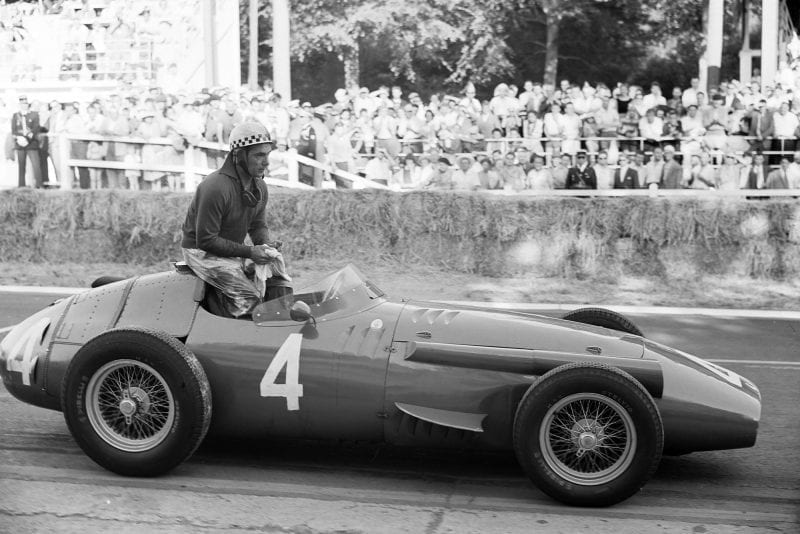
Behra’s begrimed overalls indicate the oil leak which caused his retirement
Motorsport Images
After the withdrawal of Brabham the other Cooper pulled into the pits and McDowell let the Australian take over, but he was running at the back of the field. On lap 31 Lewis-Evans arrived at the pits to complain of stiff steering and overheating, and the car was promptly withdrawn, so that by less than half-distance the race as such was over and the only British car left running was the little Cooper of Brabham.
The order was still unchanged up in front, with Fangio a comfortable 25sec ahead of Musso, who was in turn over a minute ahead of Collins. After a long gap came Behra, now suffering from a split exhaust pipe and fumes coming into the cockpit, so that Hawthorn was catching him, and Schell was coasting past the pits and down the hill trying to cool his very much overheated Maserati.
Menditeguy had gone out with a typical flourish, first of all overtaking Schell on the outside of the Rouen end hairpin, then bouncing over the straw bales, taking away some of his oil system, passing the pits in a cloud of smoke, and finally blowing the engine to pieces on the way down the hill towards Nouvelle Monde. On lap 44 Hawthorn took fourth place from Behra. but he was a whole lap behind Fangio and for the remaining 33 laps no one passed anyone.
Fangio and Musso were still going round at undiminished speed, some 25sec apart, while Collins was dropping farther and farther back, but not quite lapped by the leader. Schell’s car got worse and worse and soon began to run on five cylinders, then on four, while Behra was now getting soaked in oil from a leak from the engine, as well as being asphyxiated and burnt from the broken exhaust system.
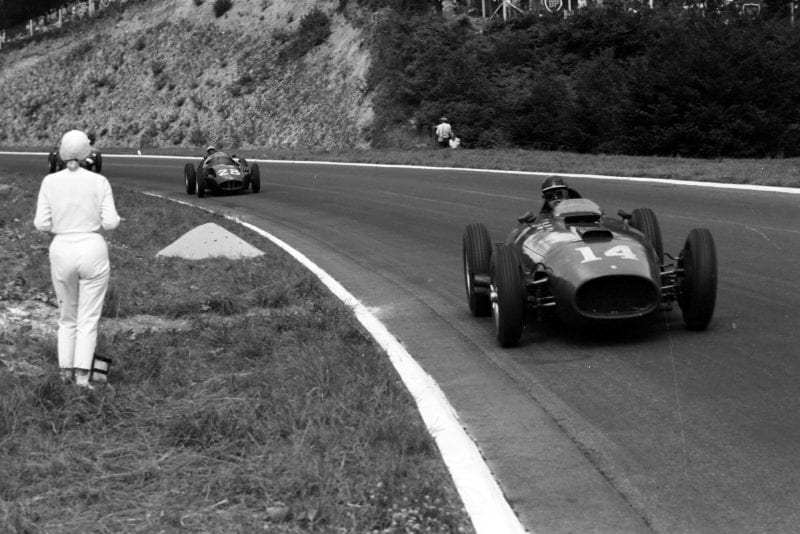
A spectator shows no fear in looking for that perfect shot as Hawthorn races by
Motorsport Images
After 60 laps there were signs in the Maserati pit that Fangio might stop to change the left-hand rear tyre, which was taking a lot of punishment on this circuit, and in consequence Musso speeded up, setting a new lap record on his 65th lap with a time of 2min 22.2sec and getting within 16sec of Fangio, but lap 67 saw his downfall, for he spun on the Nouvelle Monde hairpin, and though he did not stall his engine he was back to a 28sec gap.
“Apart from being a personal victory for Fangio, the French Grand Prix was a fine achievement for Maserati”
Fangio did not stop to change his wheel so Musso’s efforts were in vain, and “the maestro” sailed home the winner, showing without doubt his supremacy as master of the art of Grand Prix racing. The plucky Behra, who never gives in despite personal suffering, drove his car to a standstill just before the finishing line on lap 69 and waited there, grimly wiping the oil off his hands and face, until Fangio completed the race, whereupon he coasted over the finishing line to be classed fifth, just ahead of Schell, whose Maserati only just dragged itself round the last few laps.
Finally, buzzing merrily along but many laps in arrears, came Brabham with the little Cooper. Apart from being a personal victory for Fangio, the French Grand Prix was a fine achievement for Maserati, for the winning car sounded perfect at the finish, as did the three Lancia-Ferraris which were second, third and fourth, though had the World Champion been in a Maranello car the positions would have been reversed, for it seems that Fangio will win irrespective of what car he uses.
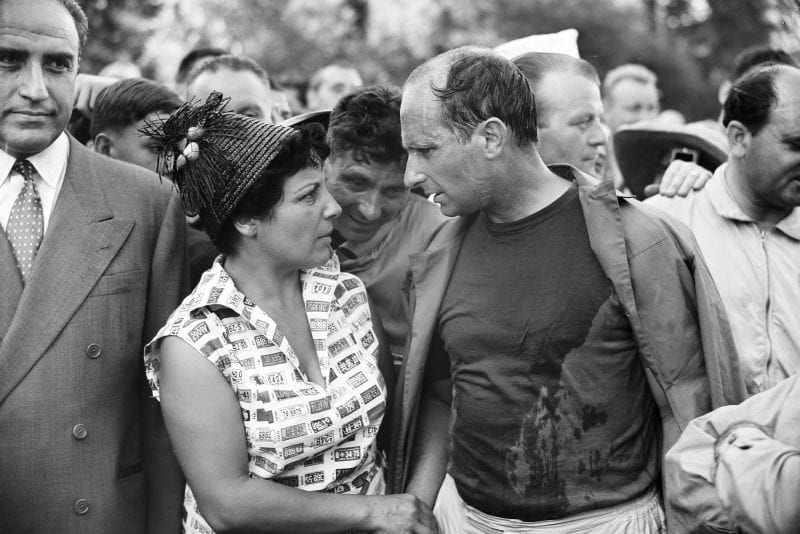
Fangio celebrates his win
Motorsport Images
Rouen Reflections
- Some of the people from Monza-lndianapolis watched the race; their main comment was: “This fellar Fangio really motor-races.”
- Mackay-Fraser must have warmed the hearts of all BRM fans, for his was the leading British car until he retired. The suspected universal seizure subsequently turned out to be a false alarm; better safe than sorry, in view of the car’s past history.
- A splendid new Press Tribune was opened on the morning of the race in memory of the late Charles Faroux.
- New transporters are really in fashion. After the appearance of the super Bartoletti-bodied Fiat of Scuderia Ferrari at Naples, Maserati produced a similar new vehicle at Le Mans, and now, at Rouen, Vanwall showed that they are as good as any with their brand new transport van.
Notes on the Cars at Rouen
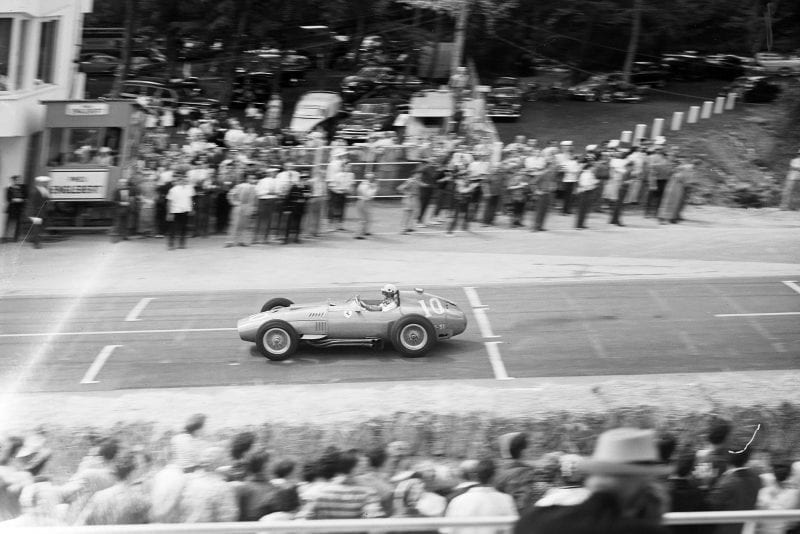
Ferrari ran all cars with the “Syracuse” bodywork
Motorsport Images
The Scuderia Ferrari cars were ostensibly as used at Monaco, all four having the 1957 “Syracuse”-type of bodywork with exposed exhaust systems. Hawthorn was driving his special spacious-cockpit model with the Super Squalo front suspension and brake assemblies, using Lancia-Ferrari drums on the front. The Scuderia Maserati had their three lightweight chassis six-cylinder cars as run at Monaco, the old experimental heavy-chassis car with the bonnet-top radiator exit, also with six-cylinder engine, and a new lightweight chassis fitted with a 12-cylinder engine.
This last car is the second development stage in the V12, the earlier appearances of this power unit being in a 1956 heavyweight chassis. Attempts were made to get cool air into the carburetter intakes by covering the whole of the top of the engine with an asbestos sheet, leaving only the carburetter trumpets protruding, these being fed by two bonnet-top air ducts. The exhaust system this time consisted of twin tail-pipes on each side ending in megaphones alongside the cockpit.
Like the 1956 chassis, this new one had re-arranged steering with the box ahead of the front axle centre line in the centre of the car, with a long column running down the vee of the engine. In the race Fangio, Behra and Schell drove the light-chassis cars and Menditeguy the old 1956 one, the V12 once again not being raced.
Of the British cars the Vanwalls were back to their normal long-nosed aerodynamic shapes, after the cut-and-shut versions that appeared at Monaco. The BRM cars had both been converted to coil-spring front suspension, with large-diameter anti-roll bars, and using the same double-wishbone layout as before. This latest modification sees the end of the oleo-pneumatic suspension struts used for so long by Bourne, for the rear ones were replaced by coil springs at Monaco, when the location of the de Dion tube by a Watt-link system was also incorporated.
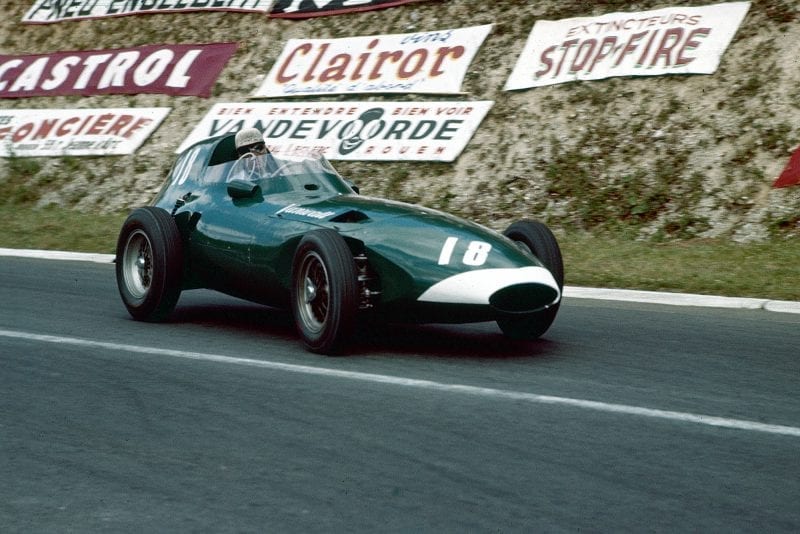
Vanwall fielded two cars
Motorsport Images
The Coopers were Formula II cars, with rear-mounted Climax twin-cam engines, the Brabham car being the 1.9litre and using drum brakes, while the McDowell car was a normal 1.5litre Formula II-engined car, using disc brakes. The spare car was also a 1.5litre, and all three twin-cam engines were fitted with pairs of double-choke Weber carburetters. To comply with the self-starting regulations the engines were fitted with starter motors, as used on the sports versions of this unit, and they were wired to a plug in the tail. A battery trolley with flexible lead was plugged in, a button at the end of the flexible lead pressed, and the starter whirled the engine into life; certainly one of the neater starter installations. All three cars were painted a dark green and the turn-out was a credit to Surbiton, even though they were not full-blooded Grand Prix cars, and were the result of a combined effort between Cooper Cars and Pippbrook Garages.
1957 French Grand Prix Race Results
| Position | Driver | Team | Time | Points |
|---|---|---|---|---|
| 1 | Juan Manuel Fangio | Maserati | 3hr 07min 46.400sec | 8 |
| 2 | Luigi Musso | Ferrari | +50.800sec | 7 |
| 3 | Peter Collins | Ferrari | +126.000s | 4 |
| 4 | Mike Hawthorn | Ferrari | +1 lap | 3 |
| 5 | Harry Schell | Maserati | +7 laps | 2 |
| 6 | Jean Behra | Maserati | +7 laps | 0 |
| 7 | Mike MacDowel | Cooper Climax | SHC | 0 |
| 7 | Jack Brabham | Cooper Climax | +9 laps | 0 |
| NC | Stuart Lewis-Evans | Vanwall | DNF | 0 |
| NC | Carlso Menditeguy | Maserati | DNF | 0 |
| NC | Roy Salvadori | Vanwall | DNF | 0 |
| NC | Herbert MacKay-Fraser | BRM | DNF | 0 |
| NC | Maurice Trintignant | Ferrrari | DNF | 0 |
| NC | Horace Gould | Maserati | DNF | 0 |
| NC | Jack Brabham | Cooper Climax | DNF | 0 |
| NC | Ron Flockhart | BRM | DNF | 0 |
Letters from Readers
N.B.—Opinions expressed are those of our Correspondents and Motor Sport does not necessarily associate itself with them. — Ed.
Monza — Two Points of View
Sir,
Recently everyone has become extremely heated about the U.P.P.I., and most people seem to have failed to give the problem any deep or unbiased thought.
The original U.P.P.I. statement suggested that they considered the Monza race on the banked circuit was highly dangerous, and that it should be replaced by a normal road race.
The Americans then said that they had not got any suitable cars for such a road race, completely overlooking the fact that Europe had not got any cars comparable with the Indianapolis Specials, which have been developed over a great number of years, and that the organisers were going around inviting European sports cars, and such antiques as the V16 B.R.M.s, to face up against the cream of American Indianapolis cars.
Another fact that is overlooked is the fact that the reputation of such drivers as Fangio and Moss would be at stake. The suggestion that they are too frightened to race around the Monza banking is too absurd for words, as most of the drivers in the U.P.P.I. have already raced there on at least one occasion.
Motor racing is in danger at the moment, as it is suffering at the hands of race promoters, who are trying to put on far too spectacular and sensational races.
The idea of the European firms spending vast sums of money on the development of cars specially for this two-race “circus,” from which it is extremely doubtful if any technical advance would arise, seems a terrible waste.
Had there been a multiple pile-up at Monza, imagine the way that the “popular” Press would have seized on the fact, and gone to great lengths to point out the real danger of such high-speed blinds, and the pointlessness of such events; thereby getting the sport a great deal of adverse publicity, which it could do very well without.
The Jaguar performance was indeed very creditable, considering the overwhelming opposition; however, it is obvious that they were completely outpaced mechanically, and only gained the places that they did owing to their outstanding reliability.
The British Racing Drivers’ Club and the Royal Automobile Club have done a great deal to raise the standard of racing and safety of tracks in Britain. However, the formation of a union so that, in the absence of anyone else, they may look after their own interests, which does concern their own lives, does not really seem so monstrous.
Although I greatly admire Mr. Jenkinson as a motor-racing journalist, I think that his attack on the U.P.P.I. is rather uncalled for, and his pointing of the finger of scorn unjustified.
I am, Yours, etc., Robert J. Weir. Yeovil.
_
Sir.
Hoo-blooming-ray; at last a voice that will be heard in the right places has echoed my own and, I am certain, many thousands of others, in “D.S.J.” “blowing his top” re G.P. racing. The conductors of these machines are paid high fees, very high, but no one, except those who know “nowt about owt,” will deny their right to these fat fees which are paid for (a) skill, and (b) because its bl— dangerous. Let them be honest and realistic enough to admit that if there were no danger of any kind, skilful as they may be, their income from racing would hardly buy the petrol.
A driver’s first duty is to the Sport and honouring his contract. Failing this, we shall shortly be seeing the U.P.P.I.sh boys passing or condemning the circuits and the cars.
These men are the “daring heroes” of our social security world. Through them and the mounts built by men who love the Sport, we, cossetted and “corsetted” customers, capture a little of the glory of the knights of old.
Well done, “D.J.S.”! Your comments will help to show these drivers that we do not like them en bloc seeking to control the Sport which made them. If they continue thus, the Sport will make other drivers, other men and other individuals!
Finally the Monza 500. In fairness, I doubt very much whether the U.P.P.I. boycotted this race entirely. I imagine that Ferrari and Maserati were not over-insistent and found this a reasonable excuse to withdraw. So far as most knowledgable racegoers are concerned, it is an excuse they didn’t need, for it was a little sickening to have the Americans demand a race under entirely American conditions. In all spheres, U.S.A. appearances on the Grids of the World would be heartily welcomed but not if they wish to dictate the type of circuit, duration and formula. Let them abide by F.I.A.
Top-flight G.P. drivers would be made to look ridiculous in an unknowledgable Press had they taken part, in road-racing 2½-litre machines, against track-racing juggernauts (Hot-Space-Rod-Van-De-Bebop-Special?)
I am, Yours, etc., Douglas O. Ingham. Teddington.
[Owing to the number of race reports in this issue further readers’ letters and Vintage Postbag are held over. — Ed.
